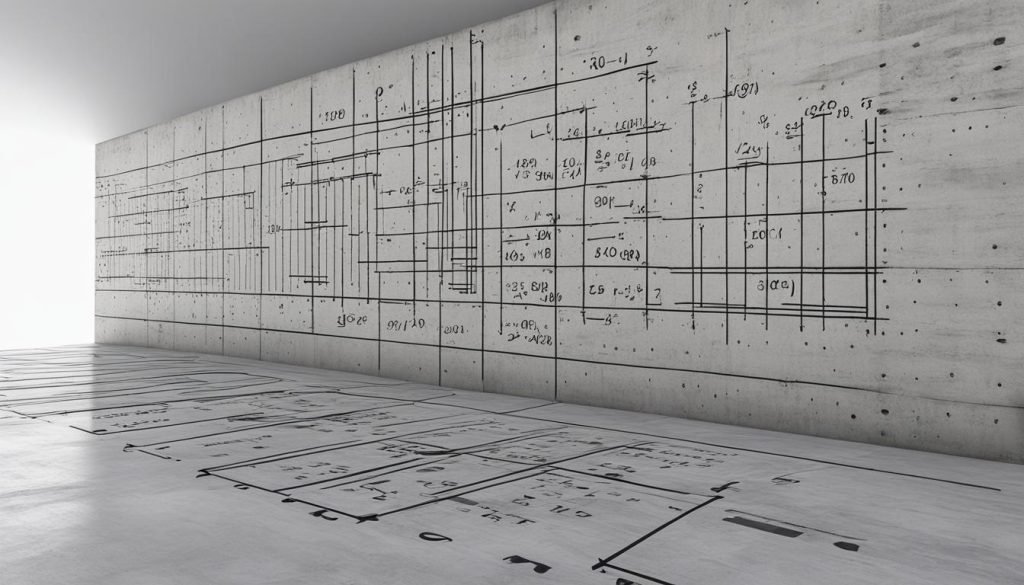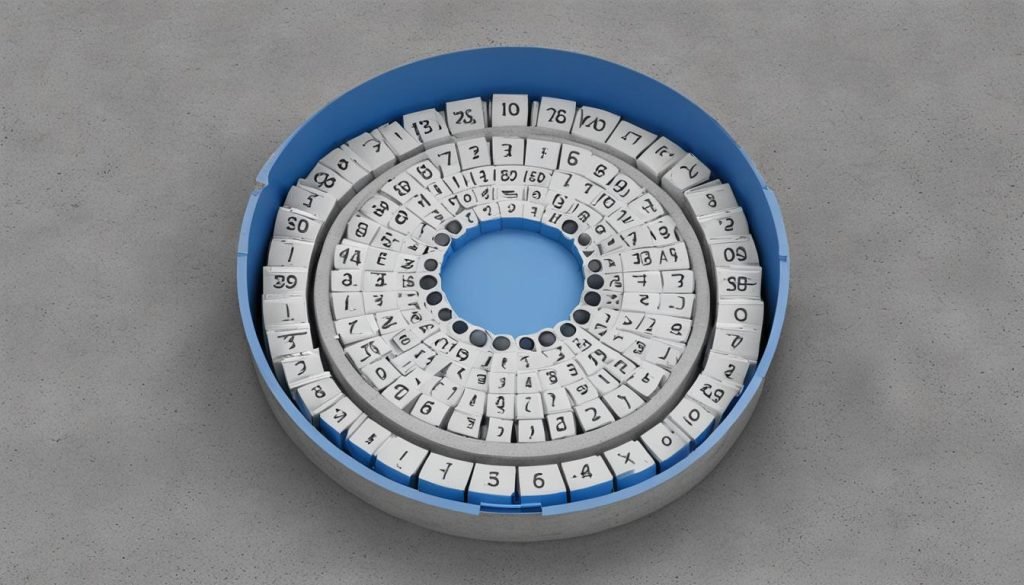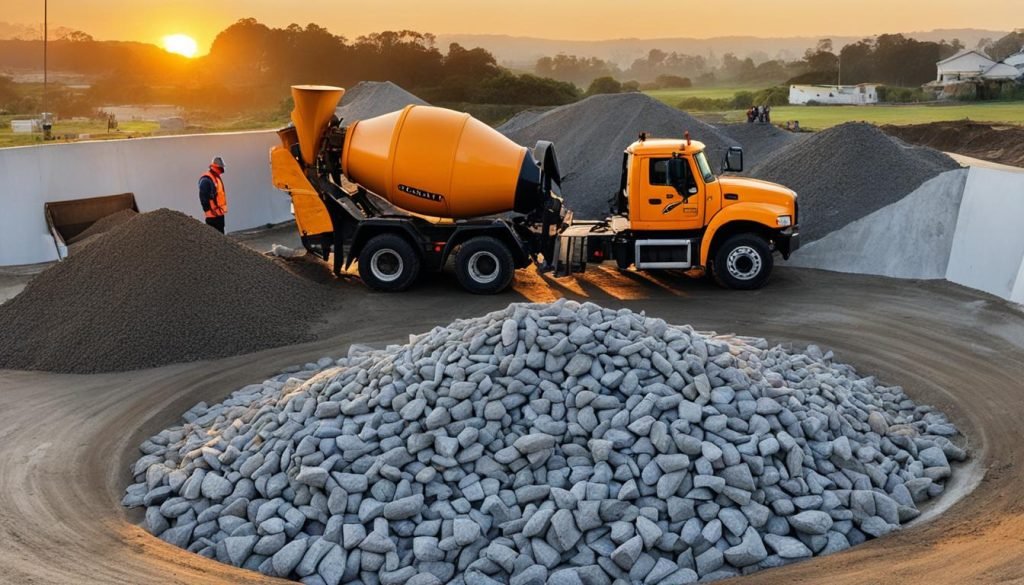Working with rounded holes in concrete requires careful calculation to ensure accurate quantities and efficient usage of materials. Whether you are filling holes for fence posts, building foundations, or any other concrete work, understanding the calculation process is essential for a successful project. In this article, we will provide you with valuable tips on how to work out concrete for round holes, including the use of concrete calculators and important considerations. Click here for Your trusted Toowoomba concrete contractors for every type of concrete work. Broaden your construction skills with this comprehensive guide on How to Build a Deck on Concrete Slab: Step-by-Step Guide. Explore valuable insights and step-by-step guidance for success in building a deck on a concrete slab.
Key Takeaways:
- Measuring the size of the posts, either round or rectangular, is the first step in calculating concrete quantities.
- Determining the dimensions of the holes, including depth and diameter, is crucial for accurate calculations.
- The number of posts you are setting will affect the amount of concrete needed for your project.
- Using a concrete calculator can help you determine the quantity of concrete required.
- Consulting with experts and considering factors like soil conditions and load requirements can ensure precise calculations.
Step 1: Size of Posts
Before calculating the concrete needed for round holes, it is essential to measure the size of your posts. The measurements will vary depending on whether you are using round or rectangular posts. For round posts, measure the diameter, while for rectangular posts, measure the width and breadth.
Converting these measurements into centimeters will ensure accurate calculations. Take note of the measurements as they will be required in the subsequent steps to determine the quantity of concrete needed for your project.
| Post Type | Measurement |
|---|---|
| Round Post | Diameter |
| Rectangular Post | Width, Breadth |
Step 2: Size of Holes
Once you have determined the size of the posts, the next step is to measure the size of the holes required for your project. The size of the holes will depend on various factors such as the type of post, soil conditions, and load requirements. It is crucial to ensure that the holes are properly sized to provide adequate support for the posts.
When measuring the size of the holes, there are two main dimensions to consider – the depth and diameter. The depth refers to how deep the hole needs to be, while the diameter is the width of the hole.
Keep in mind that the size of the holes may vary depending on the specific requirements of your project. Consulting with an expert can provide valuable insight and guidance in determining the appropriate dimensions for your holes.
In addition to the depth and diameter, it is also recommended to dig an extra 10cm below the required depth and fill it with drainage gravel. This helps with drainage and prevents water accumulation, which can potentially compromise the stability of the posts over time.
Pro Tip: When measuring the depth of the holes, be sure to include the portion of the post that will be inserted into the hole.
By accurately measuring the size of the holes and considering the use of drainage gravel, you can ensure the structural integrity and longevity of your project.
| Hole Dimensions | Depth | Diameter |
|---|---|---|
| Post 1 | 90cm | 30cm |
| Post 2 | 75cm | 35cm |
| Post 3 | 105cm | 40cm |
Using the table as a reference, you can see that each post requires a specific depth and diameter for the holes. These measurements will vary depending on the size and type of the posts used.
Step 3: Number of Posts
In this step, the number of posts you are setting plays a crucial role in calculating the amount of concrete required for your round holes. Whether you are building a fence, setting a letterbox post, or constructing other structures, the quantity of concrete needed will depend on the number of posts you have. It’s essential to consider this factor when determining the concrete requirements for your project.
“`
| Project | Number of Posts | Concrete Quantity |
|---|---|---|
| Fence | 20 | 5 cubic meters |
| Letterbox | 1 | 0.25 cubic meters |
| Shed | 4 | 1 cubic meter |
“`
As an example, let’s consider a fence construction project. If you are planning to install 20 fence posts, the concrete quantity required would be approximately 5 cubic meters. Conversely, for a single letterbox post, you would need around 0.25 cubic meters of concrete. This table demonstrates how the number of posts directly impacts the amount of concrete needed for different projects.
By accurately determining the number of posts for your specific project, you can ensure that you have sufficient concrete to complete the installation. This step is crucial for precise calculations, helping you avoid any shortages or excesses of concrete.
Step 4: Calculation
The final step is the calculation itself. To complete your project, you need to determine the quantity of concrete required. This can be done using a concrete calculator. The result will be given in cubic meters or 20kg bags, depending on the calculator used. Keep in mind that these calculations usually assume no allowance for wastage.
Slab and Wall Concrete Calculator

Apart from calculating concrete for round holes, you may also need to calculate concrete for slabs and walls. A slab and wall concrete calculator helps you determine the quantity of concrete needed for your specific project. Simply input the length, width, and thickness of the slab or wall to get the calculation.
When working with slabs and walls, it is crucial to have an accurate estimate of the concrete required. Using a slab and wall concrete calculator ensures that you don’t waste materials and helps you plan your project efficiently.
Here’s how to use a slab and wall concrete calculator:
- Measure the length of the slab or wall in meters.
- Measure the width of the slab or wall in meters.
- Measure the thickness of the slab or wall in millimeters.
- Enter these measurements into the concrete calculator.
- The calculator will provide you with the quantity of concrete required in either cubic meters or bags.
By accurately determining the concrete quantity, you can ensure that you have enough material for your project without wasting resources. Whether you’re working on a small backyard patio or a large-scale construction project, the slab and wall concrete calculator simplifies the process of calculating the required concrete.
Ensure that you have accurate measurements before using the calculator to achieve precise results for your slab and wall construction.
Round Post Hole Concrete Calculator
If you are specifically working with round post holes, there are calculators available for that as well. A round post hole concrete calculator considers the post diameter, hole depth, and hole diameter to provide an accurate calculation of the concrete needed. Be sure to enter the correct measurements for precise results.
When using the round post hole concrete calculator, follow these steps:
- Measure the diameter of the post in centimeters.
- Measure the depth of the hole in centimeters.
- Measure the diameter of the hole in centimeters.
By entering these measurements into the calculator, you will receive the accurate quantity of concrete needed for your round post hole. This ensures that you don’t overestimate or underestimate the amount of concrete required for your project.
Example Calculation:
Post Diameter: 15 cm
Hole Depth: 60 cm
Hole Diameter: 25 cm
The round post hole concrete calculator will provide you with the exact quantity of concrete necessary to fill the hole and support your post securely. With this information, you can confidently proceed with your concrete work, knowing that you have precise calculations at your disposal.
| Post Diameter (cm) | Hole Depth (cm) | Hole Diameter (cm) | Concrete Quantity (cubic meters or 20kg bags) |
|---|---|---|---|
| 15 | 60 | 25 | 0.80 m³ or 32 bags |
Square/Rectangular Hole Concrete Calculator
When working with square or rectangular holes, it is crucial to have accurate calculations to determine the required amount of concrete. The square/rectangular hole concrete calculator is a valuable tool that simplifies this process. By inputting the post width, post breadth, hole depth, and hole diameter into the calculator, you can quickly and precisely determine the concrete quantity needed for your project.
Using the square/rectangular hole concrete calculator ensures that you obtain accurate measurements, reducing the risk of over- or underestimating the required concrete. With precise calculations, you can optimize your project’s budget and materials, avoiding unnecessary waste or delays.
Here is a simple example to illustrate the effectiveness of the square/rectangular hole concrete calculator:
| Post Width | Post Breadth | Hole Depth | Hole Diameter | Concrete Quantity |
|---|---|---|---|---|
| 30cm | 40cm | 50cm | 60cm | 2.16 cubic meters |
As shown in the table above, by inputting the post width of 30cm, post breadth of 40cm, hole depth of 50cm, and hole diameter of 60cm into the square/rectangular hole concrete calculator, the result is a required concrete quantity of 2.16 cubic meters. This information allows you to plan your materials and project timeline accurately.
Using the square/rectangular hole concrete calculator saves valuable time and minimizes potential errors in manual calculations. It provides a reliable and efficient means of determining the necessary concrete quantity for your square or rectangular holes, ensuring successful project execution.
Don’t waste resources by relying on manual calculations. Utilize the square/rectangular hole concrete calculator to streamline your project, optimize your materials, and achieve precise results.
Pier Pads and Pier Holes Concrete Calculators

In addition to round and square/rectangular holes, there are specific calculators available for pier pads and pier holes. These calculators take into account the pier length, width, thickness, hole depth, and hole diameter to calculate the concrete quantity required for your project. Use the appropriate calculator based on your specific needs.
If you are working on a project that involves pier pads, the Pier Pads Concrete Calculator is a valuable tool. It considers the dimensions of the pier pads, including length, width, and thickness, as well as the depth and diameter of the holes. By inputting these measurements into the calculator, you can quickly determine the amount of concrete needed.
For projects involving pier holes, the Pier Holes Concrete Calculator is ideal. It takes into account the length, width, and thickness of the piers, as well as the hole depth and diameter. By using this calculator, you can accurately calculate the quantity of concrete required for your pier holes.
These specialized calculators save you time and effort by providing precise measurements, helping you avoid wastage and ensure your project’s success. Whether you are building a deck, a foundation, or any other structure that requires pier pads or pier holes, these calculators will simplify your concrete calculations.
Conclusion
Calculating concrete quantities for round holes is a crucial step in any construction project. By considering factors such as post size, hole dimensions, and the number of posts, you can ensure accurate measurements and avoid unnecessary wastage. Utilizing concrete calculators specifically designed for different types of holes can greatly simplify the calculation process.
However, it’s important to note that concrete calculations can be complex, and it’s always wise to consult with experts if you are uncertain about any aspect of your calculations. Professionals at Toowoomba Concreters are available to provide professional assistance for all your concrete needs.
For precise and reliable results, trust Toowoomba Concreters by calling (07) 4520 1314. Their experienced team will ensure your concrete calculations are accurate, helping you complete your project with confidence.
FAQ
How do I work out the amount of concrete needed for round holes?
To work out the amount of concrete needed for round holes, you can follow these calculation tips.
What is the first step in calculating the concrete needed for round holes?
The first step is to measure the size of your posts. If you are using round posts, you need to know the diameter. For rectangular posts, measure the width and breadth.
How do I determine the size of the holes?
Measure the depth and diameter of the holes, considering factors such as post type, soil conditions, and load requirements. Additionally, it is recommended to dig an extra 10cm and fill it with drainage gravel.
Should I consider the number of posts in the calculation?
Yes, the quantity of concrete required will depend on the number of posts you are setting. Take this into account when calculating the concrete needed for your round holes.
How can I calculate the concrete quantity?
Use a concrete calculator to determine the quantity of concrete required. The result will be given in cubic meters or 20kg bags, depending on the calculator used.
Is there a concrete calculator for slabs and walls?
Yes, a slab and wall concrete calculator helps you determine the quantity of concrete needed for your specific project. Input the length, width, and thickness of the slab or wall to get the calculation.
Is there a concrete calculator specifically for round post holes?
Yes, a round post hole concrete calculator considers the post diameter, hole depth, and hole diameter to provide an accurate calculation of the concrete needed.
Are there calculators available for square or rectangular holes?
Yes, a square/rectangular hole concrete calculator allows you to calculate the concrete quantity needed based on the post width, breadth, hole depth, and hole diameter.
Are there specific calculators for pier pads and pier holes?
Yes, there are calculators available for pier pads and pier holes. These calculators consider factors such as the pier length, width, thickness, hole depth, and hole diameter to calculate the concrete quantity required for your project.
What should I do if I’m unsure about any aspect of my concrete calculations?
Always consult experts for professional assistance and guidance regarding your concrete calculations and specific project needs.
Where can I get professional concrete assistance?
For all your concrete needs and professional assistance, contact Toowoomba Concreters at (07) 4520 1314.




